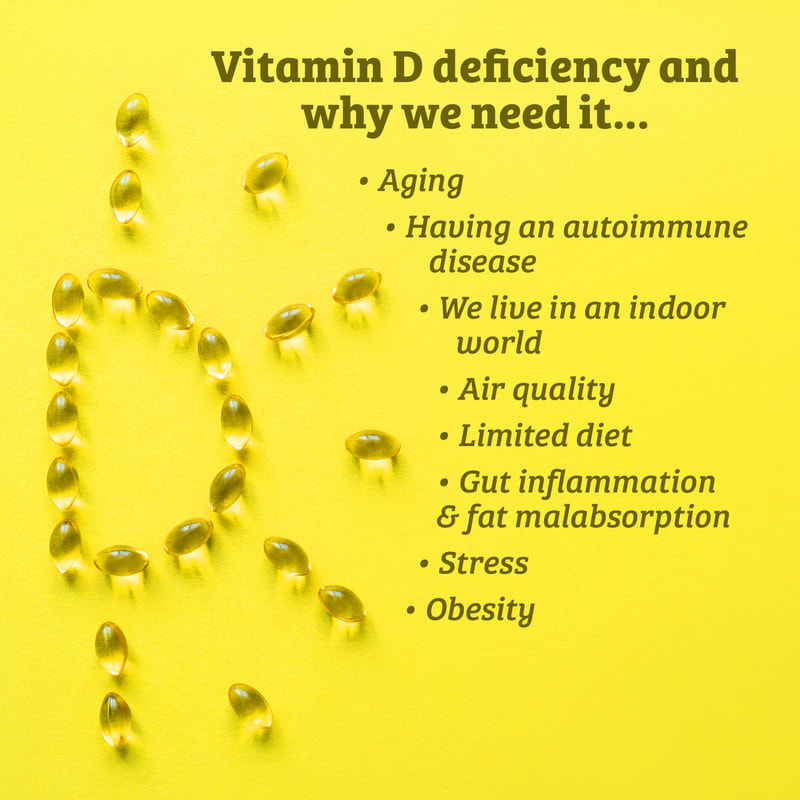Vitamin D is one of the few nutrients we can’t get enough of from food. Our bodies are designed to make vitamin D from sunlight, yet modern life in so many ways has made that very difficult. There are a number of factors that impact our ability in the absence of supplementation to maintain adequate levels of this critical vitamin: Aging. The natural process of aging affects the formation of 1,25-dihydroxyvitamin D (1,25[OH]2D calcitriol), which is the active form of vitamin D. There also is a decrease in the concentration of 7-dehydrocholesterol in the epidermis in old compared with that of young individuals and a reduced response to UV light, resulting in a 50% decrease in the formation of pre-vitamin D3. So basically, aging simply reduces vitamin D production in our skin.2 Having an autoimmune disease. Vitamin D deficiency is linked to an number of autoimmune disease and neurodegenerative diseases including: Hashimoto's; hypothyroidism; multiple sclerosis; type 1 diabetes; inflammatory bowel disorders; rheumatoid arthritis; systemic lupus erythematosus; and even Parkinson's and Alzheimer's Disease. We always wondered why MS was more common in the northern latitudes and now we know, at least in part, that this is tied to vitamin D deficiency and the degree of sun exposure. Sunlight exposure increases serum 25OHD levels by about 10 ng/mL during the months of April through September, resulting in low serum 25OHD for about 3 to 4 months in winter, with 2 additional months of low levels in more northern latitudes, such as Canada, and 2 fewer months in the southern states. Based on geographic location, individuals in northern climes are more likely to be deficient in vitamin D. We live in an indoor world. Our lifestyles even before current health events brought many of us indoors meant that we are rarely out in the sun. And if we are, we are wearing sunscreen that while its intent is to block the potentially harmful ultraviolet rays is also blocking our ability to absorb vitamin D. Air quality. Carbon particles in the air from the burning of fossil fuels, wood, and other materials scatter and absorb UVB rays, diminishing vitamin D production. In contrast, ozone absorbs UVB radiation, so pollution-caused holes in the ozone layer could end up enhancing vitamin D levels.3  Limited diet. Most people, even with the healthiest dietary plan, don’t eat the foods that contain more vitamin D, such as organ meats, salmon and fish liver oil, and egg yolks. Two foods that are fortified with vitamin D - dairy (a common immune-reactive food) and breakfast cereals (gluten and grains) - are also problematic for many people with Hashimoto’s hypothyroidism and, in my opinion, anyone with autoimmune disease. Gut inflammation and fat malabsorption Vitamin D is fat-soluble. When the gut is inflamed due to leaky gut and other inflammatory gut disorders, fat absorption is compromised and your vitamin D levels suffer. For more about the gut, microbiome and disease see our October blog: https://www.suzannegazdamd.com/blog/does-all-disease-begin-in-the-gut Stress High cortisol levels from chronic stress can deplete vitamin D levels. Obesity Two out of three adults in America are obese and one out of three are overweight. Most disturbing is that one out of every five 4-year-old children is obese! While the health risks associated with obesity are well established, studies also have shown that being obese is correlated with low vitamin D levels and that being overweight may actually affect the bioavailability of vitamin D. How much vitamin D supplementation is optimal? Low vitamin D levels have been linked to risk for every autoimmune condition as well as cardiovascular disease, cancer, poor bone health and osteoporosis, and even depression and anxiety disorders. In our practice we always check patient levels at initial consultations and workups – and just as often find these are far too low and well below the desired 60-80 range. While we generally recommend high dose D3 (not D2, which is not well absorbed), preferably 5000 IU per day of D3 PLUS K2, this should be predicated upon your individual health needs or other factors. Always consult a healthcare practitioner before adding any supplements to your regimen to make sure these are compatible with prescribed medications or care protocol. More about the benefit of D3 and K2 at our previous article Remember though that no supplement can take the place of a healthy lifestyle that starts with sound nutrition, regular sleep, stress management and avoidance of environmental toxins. You can read more in our blog section about all of these topics, just use the handy “Search” function located on each page of our website. And don’t hesitate to reach out if we can be of help – our clinics are open and happy to help you wherever you may be located! In health and hope, Dr. Suzanne Gazda References: 1 Marta Entrenas Castillo, Luis Manuel Entrenas Costa, José Manuel Vaquero Barrios, Juan Francisco Alcalá Díaz, José López Miranda, Roger Bouillon, José Manuel Quesada Gomez. “Effect of calcifediol treatment and best available therapy versus best available therapy on intensive care unit admission and mortality among patients hospitalized for COVID-19: A pilot randomized clinical study.” The Journal of Steroid Biochemistry and Molecular Biology. Volume 203, 2020, 105751, ISSN 0960-0760, https://doi.org/10.1016/j.jsbmb.2020.105751. 2 Gallagher J. C. (2013). Vitamin D and aging. Endocrinology and metabolism clinics of North America, 42(2), 319–332. https://doi.org/10.1016/j.ecl.2013.02.004 3 Harvard Health Publishing, Harvard Medical School https://www.health.harvard.edu/staying-healthy/6-things-you-should-know-about-vitamin-d
0 Comments
Your comment will be posted after it is approved.
Leave a Reply. |
AuthorDr. Suzanne Gazda, Integrative Neurology Archives
February 2024
Categories |

 RSS Feed
RSS Feed